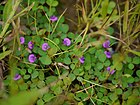Note: This is a project under development. The articles on this wiki are just being initiated and broadly incomplete. You can Help creating new pages.
Difference between revisions of "Desmodium triflorum"
| Line 1: | Line 1: | ||
[[File:Ankuca-pati (Tamil- அங்குசபாதி) (22548236966).jpg|thumb|right]] | [[File:Ankuca-pati (Tamil- அங்குசபாதி) (22548236966).jpg|thumb|right]] | ||
| + | '''Desmodium triflorum''' is a much branched, annual to perennial herb. It behaves as perennial under conditions of well-distributed rainfall and is an annual where the rainfall is seasonal. The stems are strongly branched and frequently root at the nodes. | ||
==Uses== | ==Uses== | ||
| − | {{Uses|}}, {{Uses|}}, {{Uses|}}, {{Uses|}}, {{Uses|}}, {{Uses|}}, {{Uses| | + | {{Uses|Diarrhoea}}, {{Uses|Dysentery}}, {{Uses|Thirst}}, {{Uses|Wounds}}, {{Uses|Ulcers}}, {{Uses|Skin problems}}, {{Uses|Indigestion}}. |
==Parts Used== | ==Parts Used== | ||
| − | {{Parts Used| | + | {{Parts Used|Leaves}}. |
==Chemical Composition== | ==Chemical Composition== | ||
| Line 28: | Line 29: | ||
==Habit== | ==Habit== | ||
| − | {{Habit|}} | + | {{Habit|Perennial}} |
==Identification== | ==Identification== | ||
| Line 47: | Line 48: | ||
==Mode of Propagation== | ==Mode of Propagation== | ||
| − | {{Propagation|}} | + | {{Propagation|Seeds}}, {{Propagation|Cuttings of half ripewood}}, {{Propagation|Root cuttings}} |
==How to plant/cultivate== | ==How to plant/cultivate== | ||
| − | <ref name="How to plant/cultivate"/> | + | A plant of the moist, lowland tropics, where it is found at elevations up to 1,000 metres.<ref name="How to plant/cultivate"/> |
==Commonly seen growing in areas== | ==Commonly seen growing in areas== | ||
| − | {{Commonly seen|}}, {{Commonly seen|}}, {{Commonly seen|}}, {{Commonly seen|}}, {{Commonly seen|}}. | + | {{Commonly seen|Found on a wide range of soils}}, {{Commonly seen|Heavily grazed}}, {{Commonly seen|Closely cut areas in pastures}}, {{Commonly seen|Plantations}}, {{Commonly seen|Roadsides}}. |
==Photo Gallery== | ==Photo Gallery== | ||
| Line 66: | Line 67: | ||
<references> | <references> | ||
| − | <ref name="chemical composition">[ | + | <ref name="chemical composition">[Chemistry]</ref> |
| − | <ref name="Leaf">[ | + | <ref name="Leaf">[Morphology]</ref> |
| − | <ref name="How to plant/cultivate">[ | + | <ref name="How to plant/cultivate">[http://tropical.theferns.info/viewtropical.php?id=Desmodium+triflorum Cultivation]</ref> |
<ref name="Uses">Indian Medicinal Plants by C.P.Khare</ref> | <ref name="Uses">Indian Medicinal Plants by C.P.Khare</ref> | ||
</references> | </references> | ||
Revision as of 13:14, 24 April 2020
Desmodium triflorum is a much branched, annual to perennial herb. It behaves as perennial under conditions of well-distributed rainfall and is an annual where the rainfall is seasonal. The stems are strongly branched and frequently root at the nodes.
Contents
- 1 Uses
- 2 Parts Used
- 3 Chemical Composition
- 4 Common names
- 5 Properties
- 6 Habit
- 7 Identification
- 8 List of Ayurvedic medicine in which the herb is used
- 9 Where to get the saplings
- 10 Mode of Propagation
- 11 How to plant/cultivate
- 12 Commonly seen growing in areas
- 13 Photo Gallery
- 14 References
- 15 External Links
Uses
Diarrhoea, Dysentery, Thirst, Wounds, Ulcers, Skin problems, Indigestion.
Parts Used
Chemical Composition
Common names
| Language | Common name |
|---|---|
| Kannada | |
| Hindi | |
| Malayalam | |
| Tamil | |
| Telugu | |
| Marathi | |
| Gujarathi | |
| Punjabi | |
| Kashmiri | |
| Sanskrit | |
| English |
Properties
Reference: Dravya - Substance, Rasa - Taste, Guna - Qualities, Veerya - Potency, Vipaka - Post-digesion effect, Karma - Pharmacological activity, Prabhava - Therepeutics.
Dravya
Rasa
Guna
Veerya
Vipaka
Karma
Prabhava
Habit
Identification
Leaf
| Kind | Shape | Feature |
|---|---|---|
Flower
| Type | Size | Color and composition | Stamen | More information |
|---|---|---|---|---|
| {{{5}}} |
Fruit
| Type | Size | Mass | Appearance | Seeds | More information |
|---|---|---|---|---|---|
Other features
List of Ayurvedic medicine in which the herb is used
Where to get the saplings
Mode of Propagation
Seeds, Cuttings of half ripewood, Root cuttings
How to plant/cultivate
A plant of the moist, lowland tropics, where it is found at elevations up to 1,000 metres.[3]
Commonly seen growing in areas
Found on a wide range of soils, Heavily grazed, Closely cut areas in pastures, Plantations, Roadsides.
Photo Gallery
References
- ↑ [Chemistry]
- ↑ [Morphology]
- ↑ Cultivation
Cite error: <ref> tag with name "Uses" defined in <references> is not used in prior text.
External Links
- [ ]
- [ ]
- [ ]
- Pages with reference errors
- Ayurvedic Herbs known to be helpful to treat Diarrhoea
- Ayurvedic Herbs known to be helpful to treat Dysentery
- Ayurvedic Herbs known to be helpful to treat Thirst
- Ayurvedic Herbs known to be helpful to treat Wounds
- Ayurvedic Herbs known to be helpful to treat Ulcers
- Ayurvedic Herbs known to be helpful to treat Skin problems
- Ayurvedic Herbs known to be helpful to treat Indigestion
- Herbs with Leaves used in medicine
- Habit - Perennial
- Index of Plants which can be propagated by Seeds
- Index of Plants which can be propagated by Cuttings of half ripewood
- Index of Plants which can be propagated by Root cuttings
- Herbs that are commonly seen in the region of Found on a wide range of soils
- Herbs that are commonly seen in the region of Heavily grazed
- Herbs that are commonly seen in the region of Closely cut areas in pastures
- Herbs that are commonly seen in the region of Plantations
- Herbs that are commonly seen in the region of Roadsides
- Herbs
- Pages without herbs images




